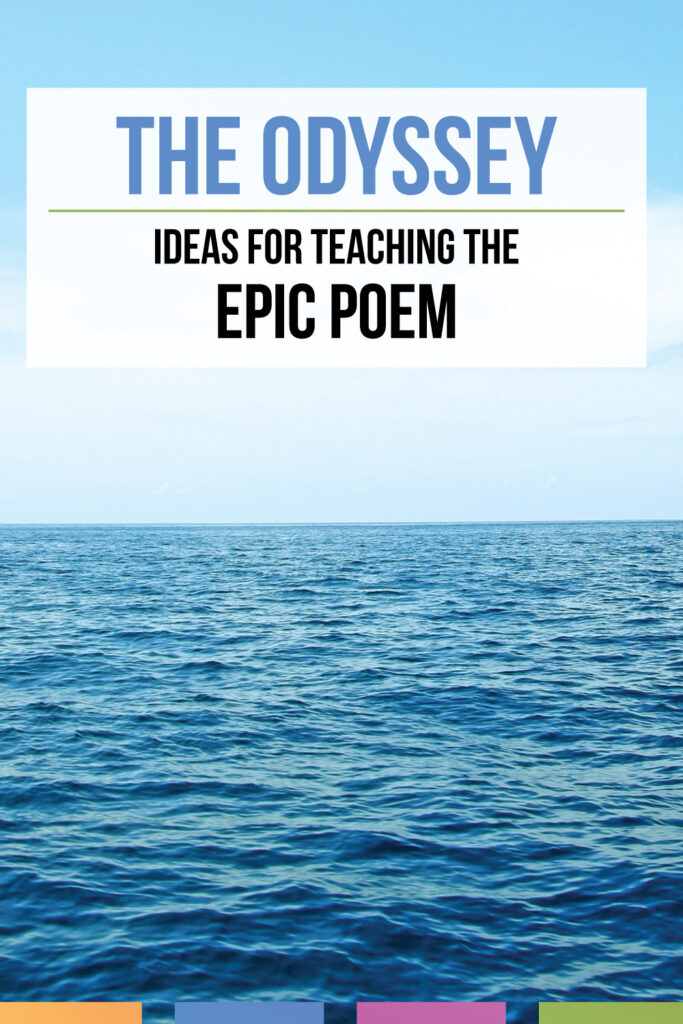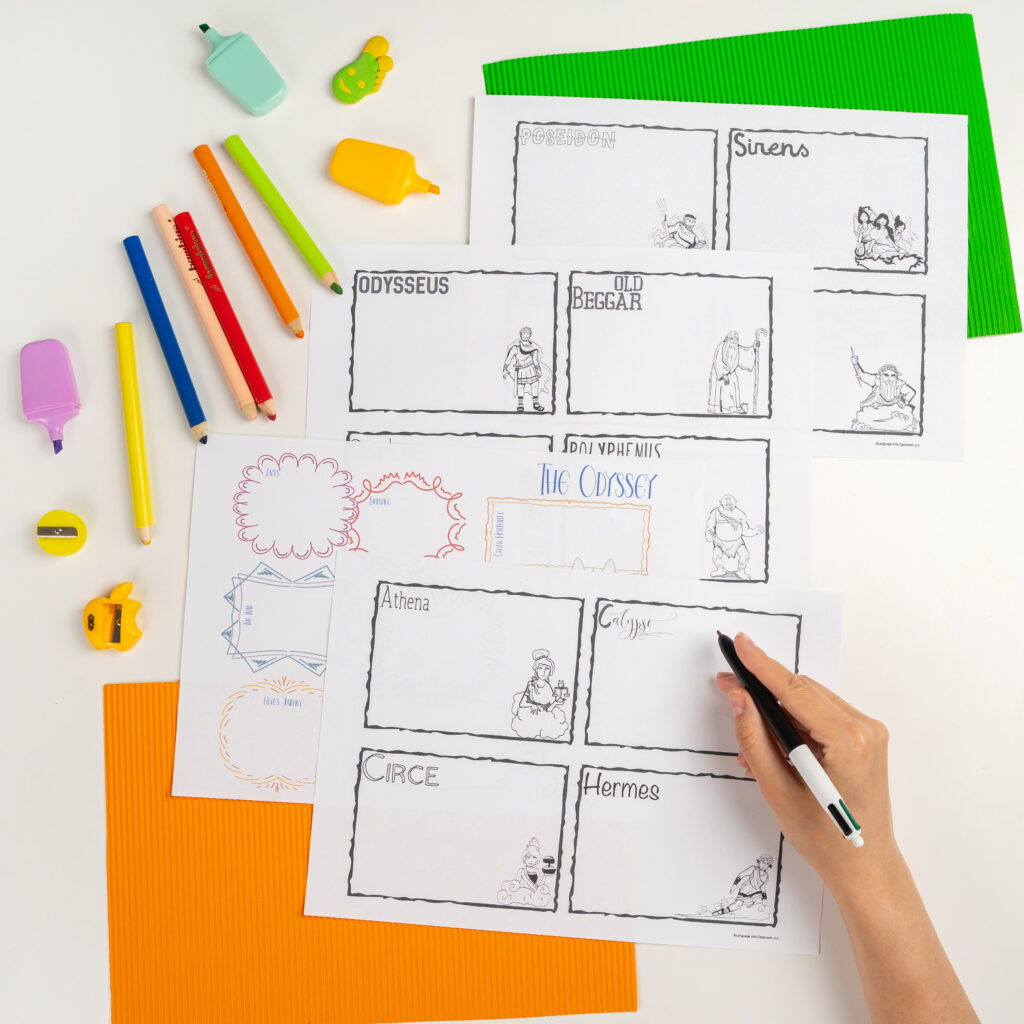Ten Activities for Teaching The Odyssey
Ten activities for teaching The Odyssey —add these pieces to your Odyssey unit!
Teaching The Odyssey can be fun, can be overwhelming, can be rewarding. When I sit and ponder what to teach with The Odyssey, I come up with several areas:
- Finding the standards I’ll meet using The Odyssey.
- Helping students with the dense language, amount of characters, and literary devices.
- Showing the bigger connections of The Odyssey to our world.
Since I have found fun activities for teaching The Odyssey, I can pass them along to others and answer some common questions along the way.
Activities for teaching The Odyssey —which version?
Many teachers’s schools give them a copy of the poem, and that (of course!) is what they use. You can create an Odyssey unit with online versions of the poem, too.
I have taught three versions in my teaching career.
Emily Wilson has a modern translation of The Odyssey that brings a fresh perspective to this ancient epic. Her version can engage students with its contemporary language and accessible style. Since Wilson is the first female translator of this poem, you will find interviews and profile publications about her to add to your unit.
I have also taught with Robert Fagles’ translation, and students find this version straight-forward. Overall, students love the graphic novel version by Gareth Hinds.
Whatever version you choose, help students appreciate the nuances and choices made by different translators and deepen their understanding of the text.
Below, I’ve included ten activities for teaching The Odyssey. No matter what your Odyssey unit looks like, you’ll be able to add some of these activities to your class.
Show Helpful Videos
Tons of helpful videos exist. Here are a few that I add to my Odyssey unit:
These videos are educational in nature. I have these and many more organized into an introductory presentation and guided notes for students. I’ve found when I front-load information, students understand this epic poem better than when I address components as students read.
Sprinkle Fun Videos
So many fun videos about The Odyssey exist that I separated them from the list above.
- Crash Course Literature
- Troy Story (I spelled that right!)
- Mount Olympus
- Ithaca Background
- Calypso and Nausicaa
Ok, these videos are fun, but yes, they are also educational. You and your students will grow in a deeper understanding of The Odyssey from these videos.
Students are probably reading an epic poem for the first time, and they can be overwhelmed. The videos will help students understand the poem, and the videos will help you to connect the poem to their lives. Plus, students will have fun.
Explore the Themes
No Odyssey unit is complete without studying the themes. Common concepts that students can develop themes and make judgements are:
- Double standards
- Hospitality
- Cycles of violence
- Heroic characteristics
You’ll be able to meet standards with The Odyssey because the story has such deep development. How, for instance, is the motif of cruelty building the theme concerning cycles of violence? Was divine intervention necessary to end cycles of violence?
Compare Versions
Several of my activities for teaching The Odyssey center on the standard that asks students to compare two mediums. Earlier in this post, I mentioned that I have taught the Robert Fagles, Emily Wilson, and Gareth Hinds versions.
The standard (for Common Core, it is standard RL.9-10.7) that asks students to compare different mediums works with the graphic novel version and another translation. I typically get my high school students into small groups, set them up with Google Slides, and ask them to focus on certain elements.
Students the assemble their focused elements (perhaps a character’s portrayal or the specific language) on individual slides with textual evidence. Then, before they present and share with classmates, they plan a small presentation. Finally, I can share all of their work with the entire class.
Review Characters
Students will need plenty of opportunities to review the characters. Since Homer’s epic poem is not written in a familiar way, you will need to check student comprehension.
Many students are familiar with mythological characters due to the popularity of the Percy Jackson series. Still, the names are new and often, the characters arrive quickly and only make a quick appearance. With character cards, students not only have images of the characters, but they also have room for taking notes.
Take “Odysseus” and the “beggar” for example. They’re the same person, but in one, Odysseus has a disguise. A motif in the story is disguises, and so students should understand the reason Athena disguises Odysseus. I’ve had students confused about Odysseus’s changes, and we’ve reviewed those scenes again.
Overall, don’t shy away from using a small reading guide for the reading. The poem is not in chronological order, and Ancient Greece customs are unfamiliar to modern readers.

Discover Literary Devices
So many literary devices interact and build this story. One ninth grade standard asks students to identify the theme’s development over the story, and pulling in the literary devices in will help students find the theme.
Here’s an example: The pun of “Nobody” in the scene with Polyphemus is a crowd pleaser. (My students, at least, always chuckle.) So, Odysseus makes a safe escape, totally fooled the cyclops. But. His hubris gets in the way, and he yells at Polyphemus that his real name is Odysseus.
The concepts get messy here, which actually is where learning can take place. Is hubris part of the epic hero? If so, is this interaction with Polyphemus building the theme of “heroic characteristics”—perhaps the idea that heroic characteristics change over time?
Again, discovering the theme is probably easy for students. Looking at its development with other components might be a challenge. I do not teach vocabulary with this poem, but I do often have word lists for students to reference—and those lists include literary devices.
Cover the Hero’s Journey
Meeting the mentor? Athena.
Tests, allies, enemies? Lots and lots of folks.
Students enjoy learning the hero’s journey because they see the pattern in their own lives, in movies they watch, and in stories they read. I use the TED video to introduce the concept (listed above).
Years ago, a colleague of mine used the movie ET to teach the hero’s journey. Since most of my students have read The Hunger Games, that story helps them understand the hero’s journey. Then, they can connect it to the story and since it is a short clip, it fits in any Odyssey unit.
Learn the History and Vocabulary
Greek traditions and customs are interesting, and readers will understand the story better if they have background information. Additionally, students need to understand the importance of hospitality and the gods to make sense of certain parts of the story.
As the Odyssey unit progresses, the plot thickens with Odysseus successfully escaping the clutches of the cunning cyclops. However, his arrogance and pride get the better of him, leading him to reveal his true identity to Polyphemus. This moment raises intriguing questions about hubris being a part of the epic hero’s character and whether heroic characteristics evolve over time.
Exploring and understanding these themes may pose a challenge for classes, but it is an opportunity for them to delve deeper into the development of heroic characteristics and their significance. Add these discussions to your Odyssey unit.
Connect with Allusions
Songs and other stories reference The Odyssey. Use some of them to expand the topic to modern day: Why do artists still reference Odysseus’s story?
A few suggestions:
- The Cave, Mumford and Sons
- Song to the Siren, Tim Buckley
- The Journey Home, Sarah Brightman
I’ve also shown students art that relates to the story. Artistic students appreciate the infusion of music and art into your Odyssey unit. A fun way to make the lessons memorable is to connect them to students’ lives.
Evaluate Homer’s Hero
Crash Course Literature (the link is above) does a great job exploring the role of the epic hero. Odysseus is indeed an epic hero.
Modern day readers don’t necessarily care for him, though. I always assure them that is fine—our standards and our expectations change over time. We have different expectations for adulthood, and it is fine to question his behavior in The Iliad.
But what does that mean for Western literature? If The Odyssey is a foundational reading of the past, has Odysseus shaped modern day heroes? Where do we see the themes of The Odyssey and the character development in our modern stories of today?
These questions make the best conversations, and they provide a meaningful way to close your Odyssey unit.
What are your final tips for curating a bundle on Odysseus’ tale?
Take your time. Annotate a version, and become familiar with the story. In order to curate a bundle on Odysseus’ tale, it is important to take your time and become familiar with the story. Annotating a version of the tale can help you navigate through its intricacies. It’s common for young readers to become confused during their initial reading, so anticipate the need to go over word lists and spend time reviewing. Mapping out your plans and incorporating various activities can engage students and bring the unit to life.
Don’t forget to provide feedback to your classes as they progress through the unit, and remember to have fun along the way.
These ten activities for teaching The Odyssey should liven any unit you’ve created. If you need materials, you can click in my materials in the picture above.


